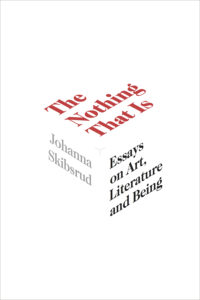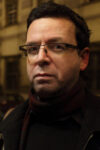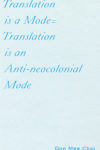The following is an excerpt from The Nothing That Is: Essays on Art, Literature and Being by Johanna Skibsrud (Book*hug Press, 2019), published with permission of Book*hug Press.
“With how many things are we on the brink of becoming acquainted, if cowardice or careless- ness did not restrain our inquiries.”
—Mary Shelley, Frankenstein
During a series of twenty-minute sessions, an EEG depicted the electrical activity occurring in artist and political activist Gustav Metzger’s brain as he attempted to think about nothing. Using this data as a set of instructions, a robot then proceeded to carve a corresponding negative shape into the interior of a fifty-centimetre cube of 145 million-year-old fossilized Portland stone. The result is Null Object, an installation by London Fieldworks (Bruce Gilchrist and Jo Joelson) from 2012.
 In two related projects from 2007, multidisciplinary artist Katie Paterson similarly explores the contingent relation between the time-bound subject and objective records of deep time. One such project, Langjökull, Snæfellsjökull, Solheimajökull, involved making sound recordings of three Icelandic glaciers that were then cast into record form using the meltwater from each glacier. The recordings were played simultaneously on three turntables, the sound of the melting glaciers intermingling with the sound of the melting records (see Katiepaterson.org). In the second project, Vatnajökull (the sound of ), Paterson placed a microphone lead into an outlet lagoon near the Vatnajökull glacier. Connected to an amplifier and a mobile phone, the microphone had the potential to transmit the sound of the melting glacier to any caller in the world.
In two related projects from 2007, multidisciplinary artist Katie Paterson similarly explores the contingent relation between the time-bound subject and objective records of deep time. One such project, Langjökull, Snæfellsjökull, Solheimajökull, involved making sound recordings of three Icelandic glaciers that were then cast into record form using the meltwater from each glacier. The recordings were played simultaneously on three turntables, the sound of the melting glaciers intermingling with the sound of the melting records (see Katiepaterson.org). In the second project, Vatnajökull (the sound of ), Paterson placed a microphone lead into an outlet lagoon near the Vatnajökull glacier. Connected to an amplifier and a mobile phone, the microphone had the potential to transmit the sound of the melting glacier to any caller in the world.
By figuring an imagined discursive space or “I-thou relation” between a speaking subject and a natural object, all three of these projects can be approached as maps, or models, of the poetic act. Each project renders palpable the way that poetic address makes nothing quite literally happen through the representation of what Jonathan Culler calls a “voice-event,” which hollows out the subject and displaces narrative time.
As Culler notes in Theory of the Lyric, what the apostrophic relation establishes is not “the description and interpretation of a past event” but “the iterative and iterable performance of an event in the lyric present, in the special ‘now,’ of lyric articulation.” In presenting a literal inscription of subjective experience within and as a natural object, London Fieldworks’ Null Object and Paterson’s glacier works evoke the slippery and often dissonant relationship between human and non-human historical records and time-scales. They provide a tangible and/or audible representation of the possibility of addressing time itself from the limited framework of human perspective. What’s more, they create the material conditions for a response to that address. This is most clearly and directly perceptible in the case of Vatnajökull’s mobile phone number (+44(0)7757001122), which presents us with both the opportunity to literally call a 2,500-year-old glacier and the sensory experience of the glacier’s response.
Null Object and Langjökull, Snæfellsjökull, Solheimajökull present a more complicated relationship between subjective call and objective response, but in both cases a conceptual space of contact is estab- lished between the limited framework of the subject and deep time. Where Null Object can be understood as a snapshot of Metzger’s address to the limits of his own subjectivity—through his attempt to think about nothing, his engagement with a technology that figures that attempt, and the juxtaposition of that figuration against fossilized stone—Paterson’s Langjökull, Snæfellsjökull, Solheimajökull both communicates the response of glacial meltwater to changing conditions over time and serves as a literal record of the past.
All three projects offer material figurations of the way that “voice-events,” produced through the address to non-human objects, serve to suspend the limitations of time-bound subjective experience precisely by confronting, and thereby confirming, that limit. Like Mary Shelley’s Doctor Frankenstein, who—wandering in another glacial landscape—comes face to face with an embodiment of his personal limitations in the form of a creature he himself has created, these projects evoke the ambiguous and contingent relation between subject and object, human and non-human.
A creature who can “exist in the ice caves of the glaciers and hide himself from pursuit among the ridges of inaccessible precipices” is a being, Doctor Frankenstein reasons, “possessing faculties it would be vain to cope with.” Feeling the restrictions of his individual agency even over the product of his own imagination, he cries out: “Oh! Stars and clouds and winds, ye are all about to mock me!” This address to what exists profoundly beyond a subjective framework serves to simultaneously accentuate and eliminate the distance between the doctor’s individual being and the natural world. “If ye really pity me, crush sensation and memory,” he continues, “let me become as nought; but if not, depart, depart, and leave me in darkness.”
Null Object and Paterson’s glacier works illustrate the paradox of poetic address Shelley’s passage evokes—palpably demonstrating that what results from poetic communication is not a causal relation between (finite) speaker and (the infinite) addressed but instead, a contingent “voice-event.” The speaker, in other words, does not and cannot erode the causal and material structures of space and time according to which a subject takes place and understands itself as a subject. However, in being brought into proximity through the pro- cess of address, the poetic act establishes a dislocated, atemporal space (Culler’s “special ‘now’”), in which a reader or interpreter is invited to confront, if not infinity—that is, the absolute in itself—then the absolute contingency of the time-bound subject on what infinitely exceeds it.
Doctor Frankenstein’s address to the universe, for example—“let me become as nought; but if not, depart, depart, and leave me in darkness”—makes “nothing happen” by inviting the reader or listener to participate in a performative “voice-event.” The layering of negatives in this particular address works to disrupt binary oppositions between presence and absence, self and other, cause and effect. The address itself stages a confrontation with “nothing” that dislocates causal and temporal flow and establishes what Culler calls a “triangulated”space of lyric encounter.
“Triangulated” address, which moves between a speaker, an (often absent) addressee, and a reader or listener, is, Culler writes, “the root-form of presentation for lyric” and the basis of all lyric poems, regardless of whether they make overt use of special modes of address such as apostrophe. Excised from a linear temporal trajectory, lyric form resists the subordination of language to interpretation, affect to effect, revolutionary possibility to historical determinism— in short, every possible representation. It is the representation of this lyric resistance to representation—to the reifying forces of history and meaning—that allows both London Fieldworks and Paterson to present the confrontation between finite subjectivity and the infinite, evoking what Walter Benjamin calls a “unique experience” of deep time as it “flashes up at a moment of danger.”
Benjamin’s elliptical “Theses on the Philosophy of History,” which counters the imposition of an “eternal” image of the past with the possibilities afforded by individual experience and memory, can perhaps best be understood through the lens of Culler’s theory of lyric address. Rather than a linear progression from past to future in which the present is just a momentary stop along the way, Benjamin argues that each moment emerges due only to “a secret agreement between past generations and the present one,” in which the past has agency and the past, present, and future exist contingently and contiguously, in constant dialogue.
Time and history are not linear in structure, in other words, but lyric. Excised from the flow of value and interpretation, what occurs—and reoccurs, continually—is the relation between subjectivity and objectivity, contingent possibility and a constantly reconfiguring set of material conditions. Both London Fieldwork’s Null Object and Paterson’s glacier works represent this relation, evoking both the revolutionary “promise” of radical interruption and change inherent within each moment and the implicit possibility that this promise will remain unrealized, bounded by the material conditions according to which it has been generated: “an act of radical interiorization and solipsism,” in Culler’s words.
By providing a three-dimensional and/or experiential model of the poetic act, however, London Fieldworks and Paterson interrupt a solipsistic understanding of the relation between “subject” and “object,” human and non-human. Rather than translating the distance between human and non-human into, on the one hand, a sublime experience of Nature or, on the other, a neoliberal discussion about the environment’s “value” and “costs,” these artists ask us to recognize the irreducible difference between subjective, finite frameworks of space and time—including the subject’s perceptions of “difference” itself, i.e., what it means to be “a subject”—and what exceeds every frame. As in Doctor Frankenstein’s address to the “stars and clouds and winds,” this tension between subject and object, human and non-human, is made palpable through juxtaposition and the illustration of distance: presence announced via reference to potential absence, the possibility of encounter charted via the triangulation of specific points of departure. What these configurations reveal is that the poetic act takes place not as a realizable “thing” but, instead, as precisely nothing. The poetic act can only be read, that is, in the negative, against that which exceeds it: as, for example, the null shape of Metzger’s thinking about nothing, or as the vanishing record of glacial time.
This, then, is what poetry offers: the opportunity to conceive of time not as causal or linear—each moment a site for potential progress, a “stop along the way”—but instead as a unique experience between subject and object, concept and form. To engage in a poetic act by seriously confronting the limits of human perspective is to expand our sense of the potential ambit of acquaintance and relation. It is also to afford agency to the deep past in relation to the present, the abstract ideal in relation to its material conditions, and the finite moment in relation to the infinite movement of time.
This post may contain affiliate links.







